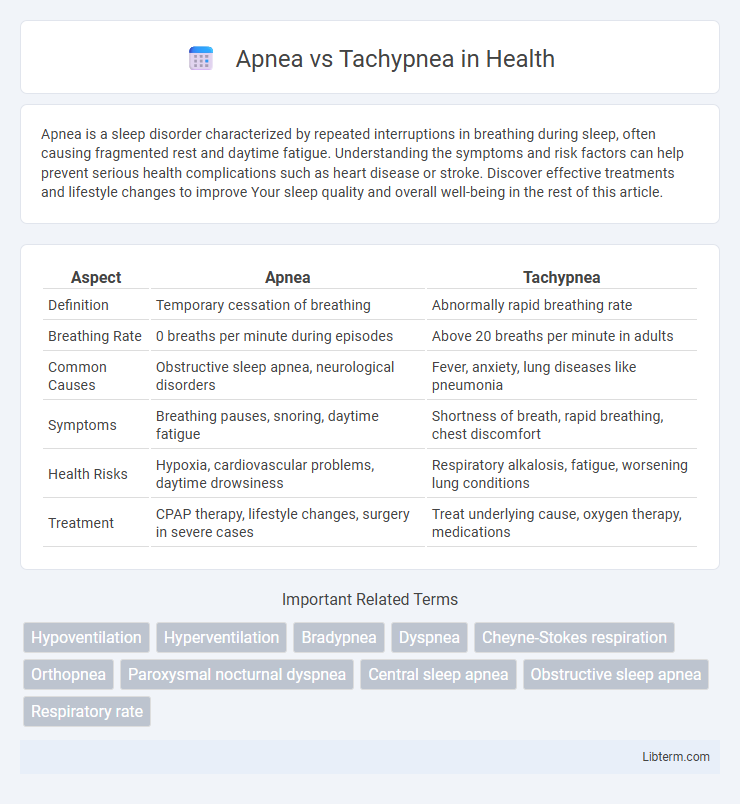Apnea is a sleep disorder characterized by repeated interruptions in breathing during sleep, often causing fragmented rest and daytime fatigue. Understanding the symptoms and risk factors can help prevent serious health complications such as heart disease or stroke. Discover effective treatments and lifestyle changes to improve Your sleep quality and overall well-being in the rest of this article.
Table of Comparison
| Aspect | Apnea | Tachypnea |
|---|---|---|
| Definition | Temporary cessation of breathing | Abnormally rapid breathing rate |
| Breathing Rate | 0 breaths per minute during episodes | Above 20 breaths per minute in adults |
| Common Causes | Obstructive sleep apnea, neurological disorders | Fever, anxiety, lung diseases like pneumonia |
| Symptoms | Breathing pauses, snoring, daytime fatigue | Shortness of breath, rapid breathing, chest discomfort |
| Health Risks | Hypoxia, cardiovascular problems, daytime drowsiness | Respiratory alkalosis, fatigue, worsening lung conditions |
| Treatment | CPAP therapy, lifestyle changes, surgery in severe cases | Treat underlying cause, oxygen therapy, medications |
Understanding Apnea and Tachypnea
Apnea is characterized by a complete cessation of breathing for at least 10 seconds, often linked to sleep disorders or respiratory conditions. Tachypnea involves an abnormally rapid respiratory rate exceeding 20 breaths per minute in adults, commonly caused by fever, anxiety, or lung diseases. Recognizing apnea and tachypnea is critical for diagnosing underlying health issues such as obstructive sleep apnea or acute respiratory distress syndrome.
Defining Apnea: Causes and Symptoms
Apnea is characterized by a temporary cessation of breathing, often resulting from obstructive, central, or mixed causes such as airway blockage, neurological disorders, or drug-induced respiratory depression. Common symptoms include loud snoring, gasping for air during sleep, excessive daytime sleepiness, and disrupted sleep patterns. Understanding apnea's underlying causes and symptoms is essential for accurate diagnosis and effective treatment to prevent complications like hypoxia and cardiovascular issues.
What is Tachypnea? Key Characteristics
Tachypnea is characterized by an abnormally rapid breathing rate, typically exceeding 20 breaths per minute in adults. This respiratory condition often signals underlying issues such as fever, anxiety, or pulmonary disorders like pneumonia and chronic obstructive pulmonary disease (COPD). Unlike apnea, which involves temporary cessation of breathing, tachypnea indicates an increased respiratory rate aimed at meeting the body's oxygen demands or expelling carbon dioxide efficiently.
Major Differences Between Apnea and Tachypnea
Apnea is characterized by a complete cessation of breathing for at least 10 seconds, often causing oxygen deprivation and interrupted sleep patterns, whereas tachypnea involves abnormally rapid breathing rates exceeding 20 breaths per minute in adults, typically as a response to hypoxia, fever, or metabolic acidosis. Apnea can be central, obstructive, or mixed in origin, often linked to neurological or airway obstruction issues, while tachypnea is primarily a compensatory mechanism to increase oxygen intake or expel carbon dioxide. The clinical implications differ significantly, with apnea posing risks of severe hypoxemia and cardiovascular stress, whereas tachypnea generally indicates underlying conditions like pneumonia, heart failure, or anxiety.
Risk Factors for Apnea and Tachypnea
Risk factors for apnea include prematurity, low birth weight, neurological disorders, and sleep apnea syndromes, often associated with underlying central nervous system dysfunction. Tachypnea risk factors encompass respiratory infections, fever, metabolic acidosis, and chronic lung diseases such as asthma or chronic obstructive pulmonary disease (COPD). Both conditions require prompt identification of underlying causes to prevent complications related to oxygen deprivation and respiratory distress.
Common Causes of Disordered Breathing
Apnea is characterized by a temporary cessation of breathing, often caused by obstructive sleep apnea, central nervous system disorders, or drug overdose, whereas tachypnea involves abnormally rapid breathing commonly triggered by fever, anxiety, lung infections, or metabolic acidosis. Both conditions can result from underlying respiratory or neurological issues, including chronic obstructive pulmonary disease (COPD) and congestive heart failure. Recognizing these causes is critical for accurate diagnosis and effective treatment of disordered breathing patterns.
Diagnosing Apnea vs Tachypnea
Diagnosing apnea focuses on detecting complete cessation of airflow lasting at least 10 seconds, often using polysomnography or overnight pulse oximetry to measure oxygen desaturation and respiratory effort. Tachypnea diagnosis involves measuring respiratory rate exceeding age-specific normal ranges, typically assessed through physical examination or capnography, highlighting rapid shallow breaths. Accurate differentiation relies on observing airflow patterns, oxygen saturation levels, and respiratory muscle activity to distinguish apnea's breathing pauses from tachypnea's increased respiratory frequency.
Treatment and Management Options
Treatment of apnea primarily involves addressing the underlying cause, such as using continuous positive airway pressure (CPAP) for obstructive sleep apnea or supplemental oxygen for central apnea, alongside lifestyle changes and monitoring. Tachypnea management targets the root condition, including administering bronchodilators for asthma, antibiotics for infections, or diuretics for congestive heart failure, combined with oxygen therapy if hypoxia is present. Both conditions require careful evaluation and tailored interventions to stabilize respiratory function and prevent complications.
Complications Associated with Apnea and Tachypnea
Apnea, characterized by temporary cessation of breathing, can lead to complications such as hypoxemia, cardiac arrhythmias, and increased risk of sudden infant death syndrome (SIDS). Tachypnea, an abnormally rapid breathing rate, often results in complications including respiratory alkalosis, dehydration, and potential respiratory failure if underlying causes are not managed promptly. Both conditions require timely diagnosis and intervention to prevent severe systemic effects and long-term morbidity.
When to Seek Medical Attention
Seek medical attention immediately for apnea if breathing stops for more than 10 seconds, especially in infants or individuals with underlying health conditions. Tachypnea requires urgent evaluation when rapid breathing is accompanied by chest pain, cyanosis, confusion, or persistent shortness of breath. Both conditions can indicate serious respiratory or cardiac issues needing prompt diagnosis and treatment.
Apnea Infographic

 libterm.com
libterm.com